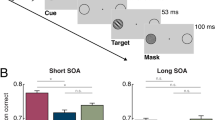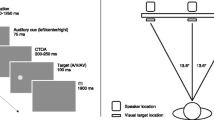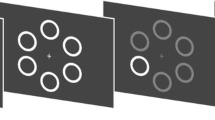Abstract
The common view on the interplay between exogenous and endogenous orienting holds that abrupt onsets are not capable of attracting attention when they occur outside the current focus of attention. Does this also apply to sudden irrelevant auditory onsets and when irrelevant visual onsets occur far in the periphery? In addition, does focused attention also reduce the alerting effect of auditory onsets, or vice versa, do highly alerting stimuli distort the attentional state? Crossmodal and unimodal variants of the Posner paradigm were examined in two experiments with targets and irrelevant onsets occurring at 28.3 and 19.3° from fixation. Either centrally presented arrows indicated the forthcoming position of visual targets to be discriminated, or warning cues signaled the likely moment of target occurrence. The targets could be preceded by peripheral auditory or visual onsets that were to be ignored. Crossmodal and unimodal exogenous orienting effects of these irrelevant onsets were observed while participants focused at the relevant side. In addition, no evidence was found that the alerting effect of auditory onsets was dependent on focused attention. Our findings indicate that, at least under the current conditions, neither crossmodal nor unimodal orienting effects of peripheral events dissipate when attention is in a focused state.



Similar content being viewed by others
Notes
Nevertheless, one might argue that the saliency of abrupt onsets may have been too small to capture attention (for a similar argument with regard to search displays, see Theeuwes 2004)
The proportion of eye movements is rather large, which seems due to the application of a conservative criterion and especially to the long time range in which no eye movements were allowed (from onset of the symbolic cue until target offset, which amounts to 1100 ms).
References
Cepeda NJ, Cave KR, Bichot NP, Kim M-S (1998) Spatial selection via feature-driven inhibition of distractor locations. Percept Psychophys 60:727–746
Cheal ML, Lyon DR (1991) Central and peripheral precuing of forced-choice discrimination. Q J Exp Psychol 43A:859–880
Coull JT, Frith CD, Büchel C, Nobre AC (2000) Orienting attention in time: behavioural and neuroanatomical distinction between exogenous and endogenous shifts. Neuropsychologia 38:808–819
Fernandez-Duque, Posner MI (1997) Relating the mechanisms of orienting and alerting. Neuropsychologia 35:477–486
Folk CL, Remington RW, Johnston JC (1992) Involuntary covert orienting is contingent on attentional control settings. J Exp Psychol Hum Percept Perform 18:1030–1044
Hommel B, Pratt J, Colzato L, Godijn R (2001) Symbolic control of visual attention. Psychol Sci 12:360–365
Hughes HC, Zimba LD (1985) Spatial maps of directed visual attention. J Exp Psychol Hum Percept Perform 11:409–430
Jonides J (1981) Voluntary versus automatic control over the mind’s eye. In: Long J, Baddeley A (eds) Attention and performance IX. Erlbaum, Hillsdale, NJ, pp 187–203
Julesz B, Hirsh IJ (1972) Visual and auditory perception—an essay of comparison. In: David EE Jr, Denes PB (eds) Human communication: a unified view. McGraw-Hill, New York, pp 283–340
Loftus GR, Masson MEJ (1994) Using confidence intervals in within-subject designs. Psychon Bull Rev 1:476–490
McDonald JJ, Ward LM (2000) Involuntary listening aids seeing: evidence from human electrophysiology. Psychol Sci 11:167–171
McDonald JJ, Teder-Sälejärvi WA, Di Russo F, Hillyard SA (2003) Neural substrates of perceptual enhancement by crossmodal spatial attention. J Cogn Neurosci 15:10–19
Müller HJ, Rabbitt PMA (1989) Reflexive and voluntary orienting of visual attention: time course of activation and resistance to interruption. J Exp Psychol Hum Percept Perform 15:315–330
Nobre AC, Sebestyen GN, Miniussi C (2000) The dynamics of shifting visuospatial attention revealed by event-related potentials. Neuropsychologia 38:964–974
Posner MI, Cohen Y (1984) Components of visual orienting. In: Bouma H, Bouwhuis DG (eds) Attention and performance X. Erlbaum, Hillsdale, NJ, pp 531–555
Scharlau I (2004) The spatial distribution of attention in perceptual latency priming. Q J Exp Psychol 57A:1411–1436
Schmitt M, Postma A, De Haan E (2000) Interactions between exogenous auditory and visual spatial attention. Q J Exp Psychol 53:105–130
Shaw ML (1984) Division of attention among spatial locations: a fundamental difference between detection of letters and detection of luminance increments. In: Bouma H, Bouwhuis DG (eds) Attention and performance X. Erlbaum, Hillsdale, NJ, pp 106–121
Spence CJ, Driver J (1996) Audiovisual links in endogenous covert spatial attention. J Exp Psychol Hum Percept Perform 22:1005–1030
Spence CJ, Driver J (1997) Audiovisual links in exogenous covert spatial attention. Percept Psychophys 59:1–22
Spence CJ, Ranson J, Driver J (2000) Cross-modal selective attention: on the difficulty of ignoring sounds at the locus of visual attention. Percept Psychophys 62:410–424
Theeuwes J (1991) Exogenous and endogenous control of attention: the effect of visual onsets and offsets. Percept Psychophys 49:83–90
Theeuwes J (2004) Top-down search strategies cannot override attentional capture. Psychon Bull Rev 11:65–70
Tipples J (2002) Eye gaze is not unique: automatic orienting in response to uninformative arrows. Psychon Bull Rev 9:314–318
Treisman AM (1960) Contextual cues in selective listening. Q J Exp Psychol 12:242–248
Van der Lubbe RHJ, Keuss PJG (2001) Focused attention reduces the effect of lateral interference in multi-element arrays. Psychol Res 65:107–118
Van der Lubbe RHJ, Woestenburg JC (2000) Location selection in the visual domain. Psychophysiology 37:662–676
Yantis S, Jonides J (1990) Abrupt visual onsets and selective attention: voluntary versus automatic allocation. J Exp Psychol Hum Percept Perform 16:121–134
Acknowledgements
The current study was supported by a grant to Albert Postma from The Netherlands Organization for Fundamental Research (NWO No: 440-20-000). Marieke Weijenberg and Carla Ruis are thanked for their help in performing the experiments. Peter Lemmens is thanked for his help in establishing the crossmodal setup.
Author information
Authors and Affiliations
Corresponding author
Rights and permissions
About this article
Cite this article
van der Lubbe, R.H.J., Postma, A. Interruption from irrelevant auditory and visual onsets even when attention is in a focused state. Exp Brain Res 164, 464–471 (2005). https://doi.org/10.1007/s00221-005-2267-0
Received:
Accepted:
Published:
Issue Date:
DOI: https://doi.org/10.1007/s00221-005-2267-0




